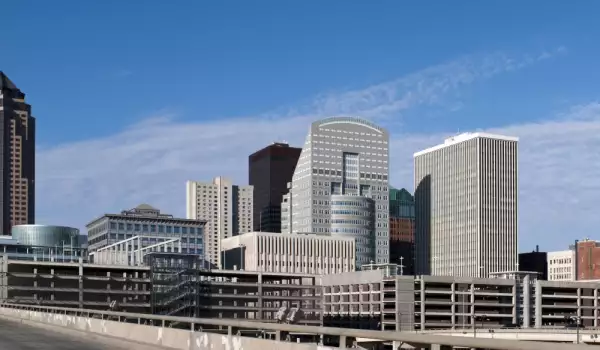Des Moines

City of Des Moines is located within the U.S. state of Iowa. It is the most populated city in the state, as well as its capital. Des Moines is the center of Polk County, but a small part of the city went to another district - Warren County. The territory of Des Moines has over two hundred and three thousand people.
Des Moines owes its name to Fort Des Moines, which was built in 1843. The fort in turn was named after the Des Moines River. The French name of the city means "monks." This is due to the fact that Frenchmen named the river after the fort - the river of the monks.

Around Des Moines River were prehistoric settlements even three thousand years ago. The territory of the modern Des Moines city has had several prehistoric settlements. They were built about thirteen hundred years BC. Archaeologists have discovered more than fifteen prehistoric burial ritual grounds.
In 1843 Captain James Allen was appointed commander of the building near Fort Des Moines. The fort was named Fort Des Moines. The fort was built to control the Indians who were brought to this area from their hometowns, which are located in the eastern part of the state.
In 1846, the fort was abandoned and the Indians were moved to another location. Many Indians, however, remained in Des Moines, where they committed illegal sale of whiskey. Even after their official move, many of them continue to return periodically in the city.
Gradually, within the abandoned fort began to settle other people. In 1846, the fort became the seat of Polk County. At that time, the territory of the fort had a church, two pubs and a larger building. All other buildings where people live were much smaller. The territory of Fort Des Moines had shops too.

In the fort were representatives of different states, and many foreigners - mostly Swedes and Danes. In 1851, exactly at the time it received the official status of city, it was completely destroyed by flooding, caused by the Des Moines River and the nearby river Raccoon. At that time, the city was called Fort Des Moines. This name was shortened to Des Moines only six years later. At the same time, the state capital moved to Des Moines.
Once the railway line passed through the town, it gave a new life to Des Moines. From 1864, began the development of coal mines in the area. One of the mines, known as the Black Diamond, runs forty-six meters deep underground and was operated by a hundred and fifty people. In 1893 the region already had twenty-three coal mines. This led to the depletion of coal resources in Des Moines. However, in the early twentieth century, Des Moines entered into the composition of workers from the United mines with over fourteen hundred employees.
The population of Des Moines and grew rapidly in the early twentieth century and it amounted to over sixty-two thousand. In the early twentieth century the decision to run the city by the mayor to be elected by the population was made. Over the years, the number of advisers changed.
One of the biggest events in the city is a great flood that happened in 1993. Rainfall during the summer raised the level of Des Moines and Raccoon rivers, until they overflowed. This caused flooding and stopping of drinking water for over two weeks. In the summer of 2008, Des Moines again suffered from flooding, but in smaller quantities.
The territory of Des Moines has many skyscrapers; many of them were built in the seventies of last century. The most famous skyscraper in the city was built before that time, the Equitable Building, which was built in 1924.















